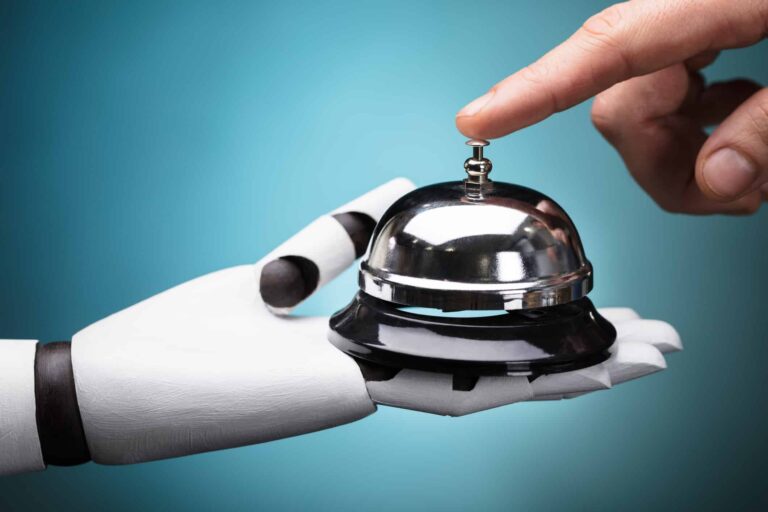October 4, 2022
Maggie Wise
Principal, Assurance & Restaurants Practice Leader
Atlanta, GA

< Back to Resource Center
Restaurants have seen customers return this year, with in-store dining and large increases in online traffic and take-out orders. Some restaurants are even seeing numbers that exceed their pre-pandemic levels.
Unfortunately, many of the people who used to work in restaurants haven’t come back to their old jobs. According to the National Restaurant Association, two out of three restaurants are understaffed, with 633,000 positions available. There are multiple theories to explain this chronic labor shortage. Whatever the reason, interest in these jobs has declined as patrons’ dining habits and expectations have changed. Now restauranteurs must adapt.
Let’s review some of the forced changes restauranteurs have made in response to labor shortages. Then we’ll look at the way artificial intelligence (AI) can help operations thrive with a smaller staff. This is an innovation that can strengthen your brand and operations while supporting a more flexible business model.
Dealing with Forced Changes
Some restaurant owners have increased wages and benefits to attract staff. Their challenge is that smaller operations are limited in the benefits they can provide. Introducing 401(k) plans and better healthcare adds overhead that may be difficult to absorb.
Other restaurants have tried reducing operating hours and seating as well as streamlining menus. These moves cut into top-line growth. To complicate matters, margins are already tight, with added pressure from supply chain inflation. Simplifying menus can help increase profitability, if managed correctly. However, it also tends to affect customer preferences and overall sales. The same is true for reduced seating. In the long term, revenues and profitability drop, especially when customers aren’t willing to wait for a table.
The solution may be to replace labor with AI. It can be a significant capital expense for some owner-operators, but there are ways to start small, scale and mitigate risk. Properly planned and executed, AI can help you build your brand and revenues. It can also prevent having to downsize.
AI Improves Efficiency
AI is changing the way most industries operate and restaurants are no exception. It handles repetitive tasks and frees up staff to focus on the patron experience. Conversational AI platforms can take over first contact with patrons. These platforms integrate with your other capital investments— your website, mobile app, kiosks, drive-through operations and point of sale (POS) systems.
Patrons are comfortable with contactless order kiosks and AI-driven virtual assistants, and AI can answer questions, make recommendations and take orders. It’s an ideal fit with interactive in-store kiosks and mobile apps. These investments drive more effective loyalty programs, personalizing rewards and acquiring customer data for more targeted marketing.
Voice AI also offers new ways to interact with customers:
- Integration with Alexa and Google, so restaurants can pull up a customer’s favorite menu items or past orders as soon as they call. This reduces ordering time from a few minutes to a few moments.
- Wendy’s has partnered with Google Cloud for speech-to-text technology to transcribe drive-through orders or by phone into text for staff. This improves accuracy even with reduced staffing. The next step will be to use voice recognition, identifying customers from previous orders and offering more personalization.
- AI-controlled kiosks increase capacity and accelerate food ordering, preparation and payment. These kiosks integrate with POS systems, kitchen display systems and mobile order solutions.
- Conversation AI handles call-ahead, web and mobile order platforms for contactless ordering. Virtual assistants answer customer queries, make recommendations and process orders.
AI Fine-Tunes Operations
AI works in the back of the house too. It consumes data as part of machine learning, to understand your customers, suppliers and operations. Your various software solutions feed a steady stream of data to AI, helping you run more efficiently.
Over time, AI learns, adapts and makes operations more efficient in multiple ways:
- Make inventory orders more predictable and reduce the amount of time required to place orders.
- Optimize labor usage for peak hours, with staffing predictions based on factors such as customer traffic, seasonality and promotions.
- Optimize your menu. AI segments customers according to tastes and preferences, looking at interaction between social networks and other media, using this data to classify customers as positive, negative or neutral. You can use this information to create targeted, more effective marketing campaigns and create dishes for customer preferences.
- Predict sales. AI algorithms learn from product promotions, social media, market trends, consumer demand and weather to predict sales. This helps you plan staffing and inventory ordering.
- Restaurants now use AI-powered analytics to increase sales with dynamic menu personalization. AI recognizes opportunities to upsell or offer unique menu items, based on historical preferences, weather or the time of day. Over time, these unique offerings build customer loyalty and retention.
Robotics — The Next Step After AI
AI isn’t the only innovation changing the way restaurants work. Robotics are now at work in larger operations, taking over repetitive tasks and meal prep:
- Robotic cooking systems prepare dishes with standardized, consistent proportions. Pizza assembly systems can be programmed to make up to 100 pizzas per hour, working with a single, unassisted operator.
- Robotics automate repetitive, back-of-houses tasks — cleaning silverware, running fry stations and dispensing beverages.
- Robotics handle cashier operations, managing transactions and freeing up employees for other tasks. These “voice bots” handle multiple orders simultaneously, process customer data and upsell.
- Robotics offer autonomous delivery, reducing pressure on staff by optimizing delivery routes, handling alerts and communicating with customers. El Pollo Loco has tested drone delivery, and other major chains are starting to consider these programs. The Federal Aviation Administration has approved drone delivery within a one nautical mile radius to deliver to thousands of households.
Strategic Resources for Growth
Independent operators and franchise groups have to handle disruptive changes, driven by the pandemic and changing dining habits. Staff shortages make these changes even more difficult to manage.
AI and other technology innovations offer new and exciting ways to engage with customers and succeed with a smaller staff. Like any other solution, these innovations must be properly planned and implemented to succeed. The Windham Brannon restaurant team can help you evaluate potential solutions and their providers. We’ll review implementation costs and map out your return on investment. For more information, talk to your Windham Brannon advisor or contact Maggie Wise, Principal at Windham Brannon.


